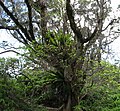File:Bobea elatior (4743750570).jpg

Original file (1,838 × 1,704 pixels, file size: 979 KB, MIME type: image/jpeg)
Captions
Captions
Summary edit
| DescriptionBobea elatior (4743750570).jpg |
ʻAhakea lau nui Rubiaceae Hawaiian endemic genus Kalauao Trail, Koʻolau Mts., Oʻahu Two indigenous ephiphytes on the tree: ʻēkaha (Asplenium nidus), flat-stemmed whiskfern or moa nahele (Psilotum complanatum) are in this tree. (See www.flickr.com/photos/50823119@N08/4743751500/in/photostr... ) Early Hawaiians had many uses for ʻahakea. It was used for canoe (waʻa) construction, the hard yellowish or reddish wood of ʻahakea was the most favorite wood for making gunwales strakes (moʻo), the forward end piece (lāʻau ihu), and the aft piece (lāʻau hope). Canoe paddles were also made from ʻahakea wood. It was also the preferred to frame hale (house) doorways and door frames (lapauila) because the reddish or yellowish colored wood was a chiefly color. Poi boards (papa kuʻi poi) were made from ʻahakea because its close grained wood. ʻAhakea, mixed with kukui nuts, was also used medicinally to help with abseces, burst sores (ʻili pūhō); scar, perhaps tuberculosis; (ʻalaʻala); and itch, ulcer (meʻeau). The bark and leaves were boiled and used to bathe in. Medicinally, moa (Psilotum spp.) was used byt he early Hawaiians for kūkae paʻa (constipation) in newborn babies and elderly men and women. It was also mixed with other plants to treat akepau (tuberculosis, consumption), and various respiratory conditions. Additionally, extracts from moa were used as laxatives. The spores were used for diarrhea in infants and used like talcum powder to prevent chafing from loincloths. Moa was also used in lei making by early Hawaiians. Early Hawaiian children would play a simple game of moa nahele (lit., chicken vegetation). Plants in Hawaiian Culture explains how this game was played: “Two children sat or stood facing one another, each holding a branched stem of moa. These they interlocked and then slowly pulled apart until the branches of one broke. The other child, without broken branches, was the winner and announced his victory by crowing like a rooster (moa).” One of the names ʻoʻō moa in fact means "cock's crow." nativeplants.hawaii.edu/plant/view/Bobea_elatior |
| Date | |
| Source |
|
| Author | David Eickhoff from Pearl City, Hawaii, USA |
Licensing edit
- You are free:
- to share – to copy, distribute and transmit the work
- to remix – to adapt the work
- Under the following conditions:
- attribution – You must give appropriate credit, provide a link to the license, and indicate if changes were made. You may do so in any reasonable manner, but not in any way that suggests the licensor endorses you or your use.
| This image, originally posted to Flickr, was reviewed on 15 November 2012 by the administrator or reviewer File Upload Bot (Magnus Manske), who confirmed that it was available on Flickr under the stated license on that date. |
File history
Click on a date/time to view the file as it appeared at that time.
| Date/Time | Thumbnail | Dimensions | User | Comment | |
|---|---|---|---|---|---|
| current | 07:14, 15 November 2012 |  | 1,838 × 1,704 (979 KB) | File Upload Bot (Magnus Manske) (talk | contribs) | Transferred from Flickr by User:Tim1357 |
You cannot overwrite this file.
File usage on Commons
There are no pages that use this file.
File usage on other wikis
The following other wikis use this file:
Metadata
This file contains additional information such as Exif metadata which may have been added by the digital camera, scanner, or software program used to create or digitize it. If the file has been modified from its original state, some details such as the timestamp may not fully reflect those of the original file. The timestamp is only as accurate as the clock in the camera, and it may be completely wrong.
| Camera manufacturer | Canon |
|---|---|
| Camera model | Canon PowerShot G3 |
| Exposure time | 1/250 sec (0.004) |
| F-number | f/8 |
| Date and time of data generation | 23:50, 19 August 2004 |
| Lens focal length | 7.2 mm |
| Horizontal resolution | 180 dpi |
| Vertical resolution | 180 dpi |
| Software used | picnik.com |
| File change date and time | 23:50, 19 August 2004 |
| Y and C positioning | Centered |
| Exif version | 2.2 |
| Date and time of digitizing | 23:50, 19 August 2004 |
| Meaning of each component |
|
| APEX shutter speed | 7.9715435469963 |
| APEX aperture | 6 |
| APEX exposure bias | 0 |
| Maximum land aperture | 2 APEX (f/2) |
| Metering mode | Pattern |
| Flash | Flash did not fire, compulsory flash suppression |
| Supported Flashpix version | 1 |
| Color space | sRGB |
| Focal plane X resolution | 8,114.2857142857 |
| Focal plane Y resolution | 8,114.2857142857 |
| Focal plane resolution unit | inches |
| Sensing method | One-chip color area sensor |
| File source | Digital still camera |
| Custom image processing | Normal process |
| Exposure mode | Auto exposure |
| White balance | Auto white balance |
| Digital zoom ratio | 1 |
| Scene capture type | Standard |